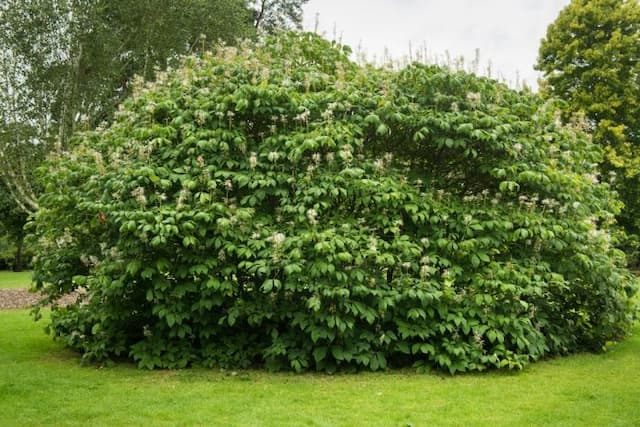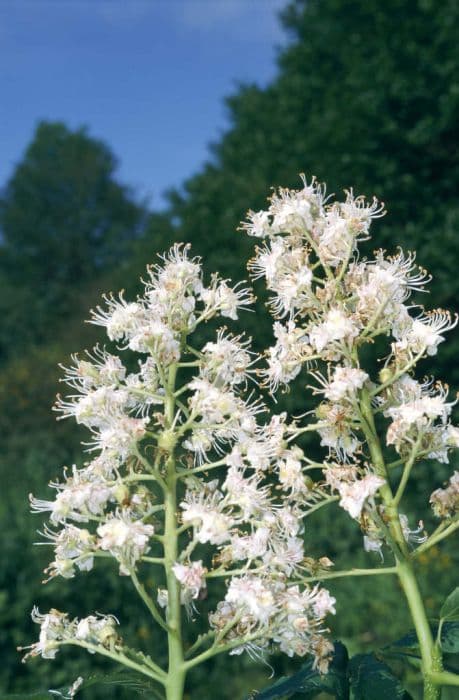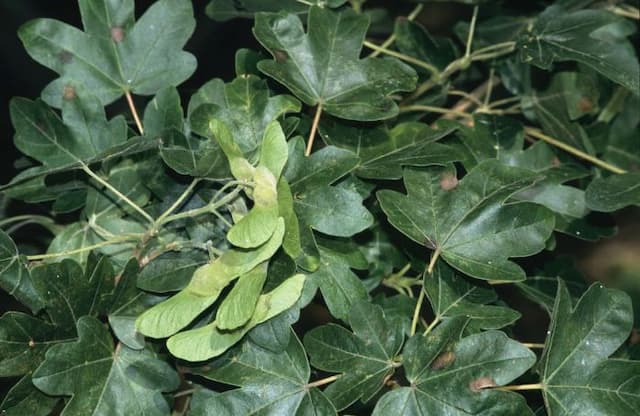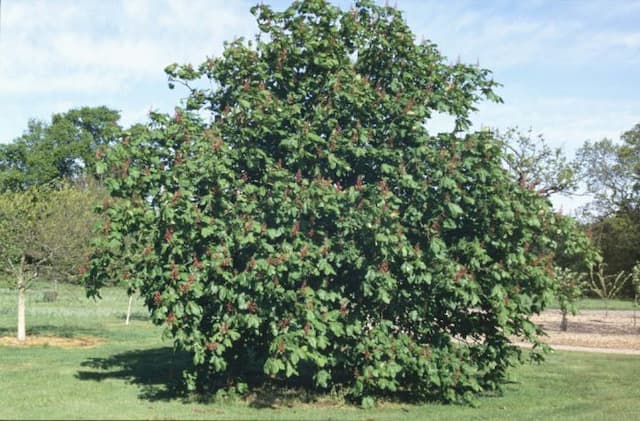Sycamore Maple Acer pseudoplatanus 'Brilliantissimum'

ABOUT
The sycamore maple 'Brilliantissimum' is a striking variety known for its unique foliage that undergoes a dazzling transformation throughout the seasons. When the leaves first emerge in spring, they display a remarkable shrimp-pink color that can be a showstopper in any landscape. The young leaves are relatively small, with a textured appearance imparted by their lobed edges which resemble the classic maple leaf shape. As the foliage matures, the pink shades gradually fade, transitioning through a spectrum that includes hues of yellow and soft green, ultimately arriving at a deeper green color during the summer months. This metamorphosis offers a dynamic visual display that changes the character of the tree as the season progresses. In autumn, the tree presents another spectacular show, when the leaves turn again, this time into a medley of gold and yellow before they finally fall. The bark of the tree is grey with a typical texture that becomes more rugged with age. Beneath the leaves, the sycamore maple 'Brilliantissimum' is also known to have red-colored stems that contrast beautifully with the lighter colors of the changing leaves, adding yet another layer of decorative interest to this ornamental variety. Owing to its distinctive appearance throughout the year, the sycamore maple 'Brilliantissimum' is a favorite among garden enthusiasts who desire a tree that provides seasonal interest and a kaleidoscope of colors.
About this plant
 Names
NamesFamily
Sapindaceae.
Synonyms
Sycamore Maple 'Brilliantissimum', Brilliantissimum Maple.
Common names
Acer pseudoplatanus 'Brilliantissimum'
 Toxicity
ToxicityTo humans
The Sycamore Maple is generally considered to have low toxicity to humans. However, ingestion of parts of the plant, especially the seeds, can lead to mild symptoms such as abdominal pain or discomfort in some individuals. There are no severe toxic consequences commonly associated with this tree for humans.
To pets
For pets, specifically horses, the Sycamore Maple can be more problematic. It contains a toxin called hypoglycin A, which is found in the seeds (samaras) and seedlings. Ingestion of these parts can cause a condition known as Atypical Myopathy, a serious and potentially fatal muscle disease that leads to muscle weakness, stiffness, and in severe cases, muscle breakdown. The symptoms can also include reluctance to move, difficulty breathing, colic-like signs, and in severe cases, sudden death. Pet owners should prevent animals from grazing on fallen seeds and seedlings from this tree.
 Characteristics
CharacteristicsLife cycle
Perennials
Foliage type
Deciduous
Color of leaves
Pink
Flower color
Yellow-green
Height
20 feet (6 meters)
Spread
15 feet (4.5 meters)
Plant type
Tree
Hardiness zones
5
Native area
Europe
Benefits
 General Benefits
General Benefits- Aesthetic Appeal: The Acer pseudoplatanus 'Brilliantissimum', commonly known as the Sycamore Maple, is prized for its stunning foliage, which changes color throughout the seasons, adding year-round interest to gardens.
- Shade Provider: The tree's size and dense canopy make it a good provider of shade, making outdoor spaces more enjoyable during sunny days.
- Habitat for Wildlife: It offers habitat and food for local wildlife, such as birds and small mammals, supporting biodiversity.
- Windbreak: When planted in groups, the Sycamore Maple can serve as a windbreak, protecting against soil erosion and offering shelter from harsh winds.
- Urban Tolerance: It is relatively tolerant to urban pollution and soil compaction, making it suitable for city landscapes.
- Low Maintenance: Once established, this tree requires minimal upkeep beyond occasional pruning, making it a convenient choice for both private and public spaces.
- Adaptability: This species can adapt to a wide range of soil types and environmental conditions, enhancing its viability in different settings.
- Seasonal Interest: Beyond its colorful spring foliage, the tree also produces discrete flowers and winged seeds that add to its ornamental value.
 Medical Properties
Medical PropertiesThis plant is not used for medical purposes.
 Air-purifying Qualities
Air-purifying QualitiesThis plant is not specifically known for air purifying qualities.
 Other Uses
Other Uses- Woodworking: The wood of Acer pseudoplatanus 'Brilliantissimum' can be used for fine woodworking projects such as musical instruments and furniture due to its even grain and workability.
- Edible Syrup: Similar to other maples, the sap of this Sycamore Maple can be tapped and reduced to make a sweet syrup or sugar, though its sugar concentration is lower than the sugar maple.
- Dye Production: The leaves and bark of the Sycamore Maple can be used to create natural dyes for textile coloring.
- Education and Research: The easily observable changes in leaf color of Acer pseudoplatanus 'Brilliantissimum' make it a useful subject for botanical studies and educational purposes in plant development.
- Art and Craft Material: The distinctive leaves can be pressed and used in art projects or botanical displays.
- Horticultural Training: Pruning and caring for this cultivar provides an opportunity for horticulturalists to train in tree maintenance and health management.
- Photography: This tree with its changing leaf colors provides a photogenic subject for nature photographers, particularly in the spring when the leaves are a bright pinkish-red.
- Cultural Symbolism: In some cultures, the tree may be utilized in festivals or ceremonies as a symbol of certain qualities such as strength or endurance given its robust nature.
- Soil Improvement: When used in agroforestry, the fallen leaves of the Sycamore Maple decompose and can improve soil fertility and structure over time.
- Noisemaker: Dried seed pods, known as samaras or helicopter seeds, can be used by children as natural noisemakers as they spin and whistle in the wind when thrown.
Interesting Facts
 Feng Shui
Feng ShuiThe Sycamore Maple is not used in Feng Shui practice.
 Zodiac Sign Compitability
Zodiac Sign CompitabilityThe Sycamore Maple is not used in astrology practice.
 Plant Symbolism
Plant Symbolism- Strength and Endurance: The common name of Acer pseudoplatanus 'Brilliantissimum' is the sycamore maple. As a member of the maple tree family, the sycamore maple often symbolizes strength and endurance because of its hardy nature and its ability to withstand various climates and conditions.
- Protection: In some cultures, trees are seen as protective entities. The sycamore maple, with its broad leaves and sturdy trunk, is no exception, providing shelter and shade to those around it.
- Adaptability: The sycamore maple's ability to adapt to different soil types and urban environments signifies adaptability and resilience in the face of change.
- Beauty and Elegance: The 'Brilliantissimum' variety, with its striking salmon-pink young leaves that change to yellow-green, is admired for its ornamental beauty, signifying elegance and aesthetic appreciation.
- Growth and Expansion: As a tree that can reach considerable heights and widths, the sycamore maple symbolizes growth and expansion, encouraging one to reach new heights in their pursuits.
 Water
WaterThe Sycamore Maple 'Brilliantissimum' should be watered deeply once a week during its growing season, particularly if the weather is dry. During the hotter summer months or in warmer climates, water usage may increase to approximately 15-20 gallons per week for a young tree, ensuring that the soil is moist but not waterlogged. Mature trees may require less frequent but deeper watering, perhaps 20-30 gallons every two weeks, to encourage deep root growth and drought tolerance. In the fall and winter, reduce watering as the tree goes dormant and requires less moisture. Always check the soil moisture level a few inches below the surface; if it feels dry, it's time to water.
 Light
LightSycamore Maples, including 'Brilliantissimum', prefer full sun to partial shade. It's best planted in a location where it can receive at least four to six hours of direct sunlight daily, which will help promote the best leaf color and overall vigor of the tree. Though tolerant of light shade, too much shade can lead to less vibrant leaf color and reduced health of the tree.
 Temperature
TemperatureThe Sycamore Maple 'Brilliantissimum' can withstand a wide range of temperatures but thrives best in temperatures between 50°F and 80°F. It is cold-hardy and can survive temperatures as low as -20°F, making it suitable for many temperate regions. Conversely, it can also handle the heat up to around 90°F, beyond which it may require additional watering to cope with stress.
 Pruning
PruningPrune the Sycamore Maple 'Brilliantissimum' to remove any dead, diseased, or crossing branches and to maintain its shape. The best time for pruning is late winter or early spring before the sap starts to flow, typically once a year. This helps to prevent 'bleeding' and encourages wound closure before the onset of the growing season. Pruning also promotes air circulation and light penetration within the canopy, important for the tree's overall health.
 Cleaning
CleaningAs needed
 Soil
SoilSycamore Maple 'Brilliantissimum' prefers well-drained, fertile soil with a slightly acidic to neutral pH, ideally between 5.5 and 7.5. The best soil mixture can be created with loamy garden soil, compost, and organic matter to enhance nutrients and structure. Mulching helps maintain moisture and soil temperature.
 Repotting
RepottingThe Sycamore Maple 'Brilliantissimum' is typically planted outdoors and doesn't require repotting. In a container, young trees may be repotted every 2 to 3 years, while mature trees should be root pruned instead of repotted if necessary.
 Humidity & Misting
Humidity & MistingSycamore Maple 'Brilliantissimum' tolerates a wide range of humidity levels and generally adapts to the ambient outdoor humidity where it is planted. Specific humidity levels aren't crucial for its growth, as it's quite hardy.
 Suitable locations
Suitable locationsIndoor
Provide bright, indirect light and ample space for growth.
Outdoor
Plant in well-draining soil, full sun to partial shade.
Hardiness zone
4-7 USDA
 Life cycle
Life cycleThe life of Sycamore Maple 'Brilliantissimum' begins with germination, where the seeds, released in the fall, sprout when conditions are suitable, typically in spring. After germination, the seedling stage involves the establishment of roots and the first shoots, developing into a young plant with characteristic salmon-pink foliage in spring, maturing to yellowish-green. During the vegetative growth stage, the plant will continue to grow in height and girth, developing a more extensive root system and a woody trunk, where it can reach up to 15-20 meters in a landscape setting over several years. Once mature, the tree flowers in early spring, with small, greenish-yellow flowers that are attractive to pollinators, followed by the development of its distinctive winged seeds, called samaras. The reproduction stage involves the dispersal of these samaras by wind, allowing for the establishment of new individuals away from the parent tree. Finally, the Sycamore Maple 'Brilliantissimum' reaches its senescence phase, where growth slows, and the tree may show signs of aging before eventually dying, completing its life cycle.
 Propogation
PropogationPropogation time
Spring-Early Summer
The most popular method of propagation for the Sycamore Maple 'Brilliantissimum' is by seed. Timing is critical for seed propagation, and it is best to collect the seeds as they mature, which typically happens in the fall. Once collected, the seeds require a period of cold stratification to break dormancy; this can be done by mixing the seeds with moist sand and storing them in a refrigerator at approximately 34 to 41 degrees Fahrenheit (1 to 5 degrees Celsius) for one to three months. After the stratification period, the seeds can be sown in pots or trays filled with a well-draining soil mix and placed in a protected area with indirect light. Seedlings will emerge in the spring and can be transplanted to their permanent locations once they have developed a robust root system and are of sufficient size to handle the stresses of outdoor conditions.









